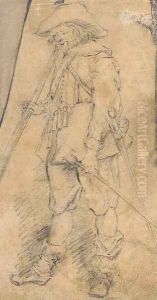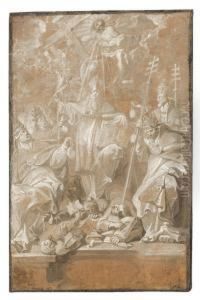Antoine Sallaert Paintings
Antoine Sallaert was a notable figure in the Flemish Baroque painting movement, an era that fostered a dynamic and visually rich style of art in the Southern Netherlands during the 17th century. Born in 1580 in Brussels, which was then part of the Habsburg Netherlands, Sallaert emerged as an influential artist and a pivotal force in the cultural landscape of his time. His work, deeply entrenched in the Baroque ethos, is characterized by dramatic expression, vigorous detail, and a profound sense of movement, aligning him with the broader trends of European art during that period.
Sallaert's contributions were not limited to his individual artworks; he played a significant role in the artistic community of Brussels. He was a master in the Brussels Guild of Saint Luke by 1613, a testament to his skills and reputation among his contemporaries. His involvement in the guild underscores his influence in shaping the local art scene, mentoring young artists, and contributing to the flourishing of Baroque art in the region.
Throughout his career, Sallaert demonstrated a versatility in subjects, ranging from religious themes to mythological scenes and portraits. His ability to imbue his paintings with emotional depth and a sense of immediacy was admired by his patrons and the public alike. Notable works include various altarpieces for local churches, which exhibit his skillful handling of light and shadow to create dramatic focal points. Sallaert's art was not only appreciated in his homeland but also attracted attention across Europe, contributing to the spread of the Flemish Baroque style.
Despite his success, detailed records of Sallaert's life remain scarce, and many of his works have been attributed to him only through stylistic analysis and archival research. After a prolific career, Antoine Sallaert died in 1650 in Brussels. His legacy, however, continues to be celebrated for its contribution to the richness and diversity of Baroque art. The enduring appeal of his work lies in its ability to capture the complexity of human emotions, rendered with a technical mastery that remains captivating to this day.

